Did you know that 5 out of every 10 Filipinos live in cities today? By 2050, this number is expected to rise to 84%. This rapid urbanization highlights the importance of thoughtful city design and development. But where did these ideas originate?
Many of the principles shaping modern Philippine cities trace back to historical influences. For example, the grid layout and intentional design of public spaces were concepts brought to the Philippines centuries ago. These ideas continue to guide how cities grow and function today.
Take Barcelona as a case study. Once a small Roman settlement, it transformed into a thriving metropolis through strategic planning. Its emphasis on accessibility, public spaces, and sustainable development serves as a model for cities worldwide, including those in the Philippines.
As we explore the lasting impact of these historical practices, we’ll uncover how they shape the urban areas we live in today. From policy implementation to project development, these principles remain at the heart of modern city planning.
Key Takeaways
- Over half of Filipinos currently live in cities, with urbanization expected to grow.
- Historical planning principles, like grid layouts, influence modern city design.
- Barcelona’s transformation serves as a model for urban development.
- Public spaces and accessibility remain key goals in city planning.
- Historical practices continue to shape policy and project implementation.
Introduction to Urban Planning Concepts
The way cities are designed directly impacts the quality of life for their residents. Effective planning ensures that areas grow sustainably, with access to essential services and green spaces. At its core, urban planning involves organizing land use, transportation, and public spaces to create functional and livable environments.
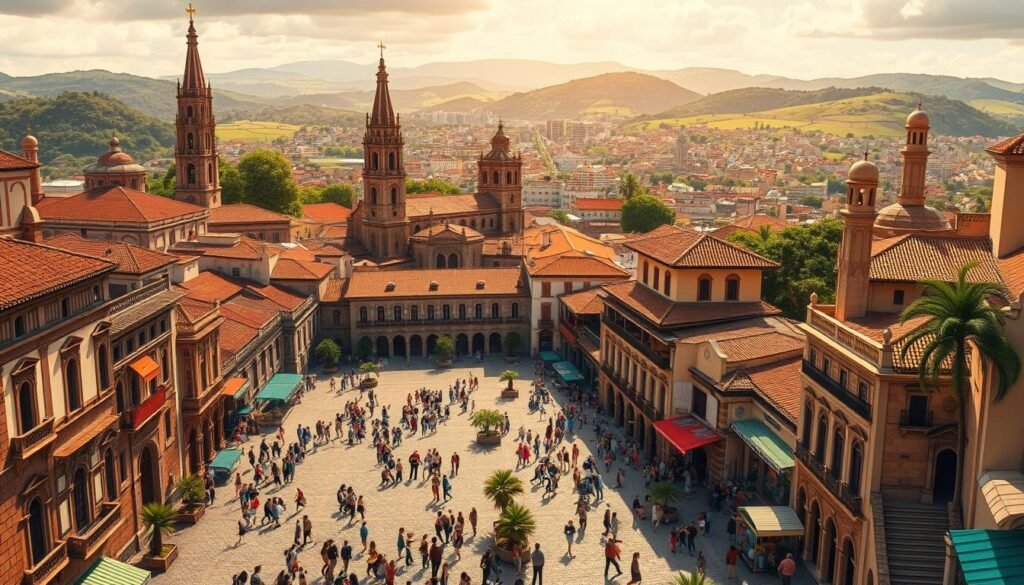
Understanding the Basics of Urban Planning
Urban planning is the process of designing and managing the physical layout of a city. It includes decisions about land use, road networks, and public facilities. A well-planned city balances residential, commercial, and recreational areas to meet the needs of its population.
Historically, grid systems have been a popular approach. These layouts divide land into rectangular blocks, making it easier to navigate and develop. Public spaces, like parks and plazas, are also key components, providing areas for community interaction and recreation.
Influences on Modern City Development
Modern city design is shaped by historical practices and evolving needs. Early planners focused on creating order and efficiency, which still influences today’s projects. For example, the concept of designated green spaces emerged to improve air quality and offer recreational opportunities.
Policy decisions by city councils play a crucial role in shaping urban areas. From zoning laws to infrastructure projects, these policies guide how cities grow and adapt to change. Sustainable development is now a priority, with planners aiming to reduce environmental impact while improving quality of life.
| Concept | Description | Impact |
|---|---|---|
| Grid Systems | Divides land into rectangular blocks for organized development. | Improves navigation and land use efficiency. |
| Public Spaces | Designated areas like parks and plazas for community use. | Enhances social interaction and recreation. |
| Sustainable Development | Focuses on reducing environmental impact while meeting urban needs. | Promotes long-term ecological and economic health. |
As cities continue to grow, the principles of urban planning remain essential. By learning from the past and adapting to new challenges, planners can create cities that are both functional and sustainable for future generations.
The Historical Roots of Spanish Urban Planning
The foundations of modern city layouts can be traced back to ancient practices. Early designs were not just functional but also strategic, shaping how cities evolved over centuries. From Roman grids to medieval walls, these historical influences laid the groundwork for today’s urban development.
Legacy from Roman Foundations to Medieval Grids
Roman cities like Barcino (modern-day Barcelona) were built on grid systems. These layouts divided land into uniform blocks, making navigation and development easier. Streets were straight and wide, ensuring efficient movement and clear boundaries.
Medieval cities, however, prioritized defense. Walls were built to protect settlements, limiting their size. Over time, these walls became barriers to growth, prompting a shift toward more open and planned areas.
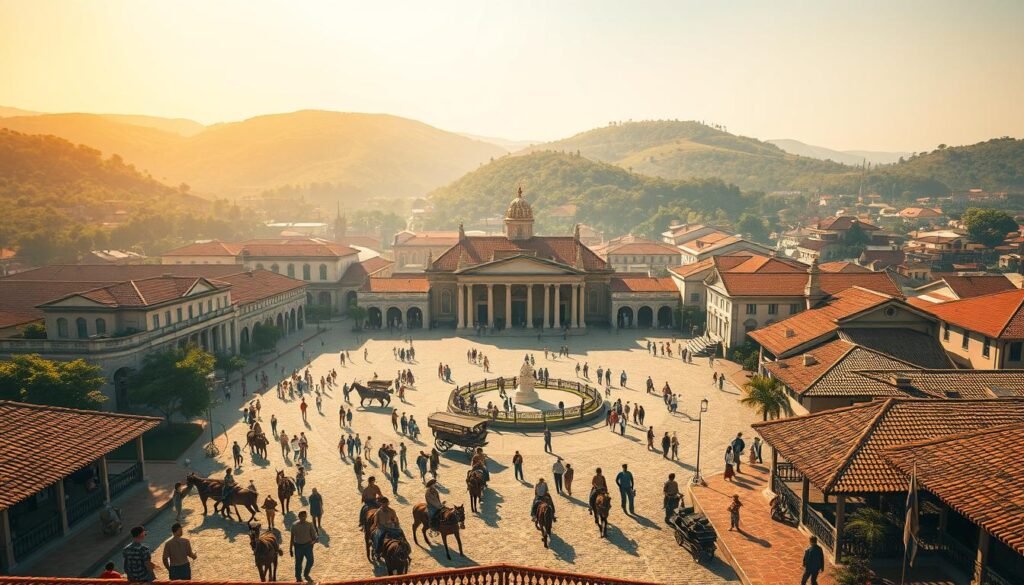
Transition from Defensive Walls to Controlled Expansion
As cities grew, defensive walls were no longer practical. Planners began to focus on controlled expansion, creating uniform blocks and organized streets. This shift allowed cities to accommodate larger populations while maintaining order.
Barcelona is a prime example of this transition. In the 19th century, the city expanded beyond its medieval walls. Planners like Ildefons Cerdà introduced the Eixample district, featuring a grid layout with wide streets and uniform blocks. This design improved accessibility and set a standard for modern city planning.
- Roman grids provided the foundation for organized city layouts.
- Medieval walls prioritized defense but limited growth.
- Controlled expansion led to uniform blocks and wider streets.
- Barcelona’s Eixample district exemplifies this evolution.
These historical practices continue to influence modern city design. By understanding their origins, we can better appreciate the principles that shape our urban environments today.
Spanish Urban Planning and Its Core Principles
Cities thrive when built on principles of order and flexibility. The foundation of effective city design lies in intentional layouts, predefined boundaries, and integrated public spaces. These elements work together to create environments that are both functional and adaptable.
Intentional City Design and Geographic Boundaries
Intentional design ensures uniformity in building blocks and infrastructure. This approach, pioneered by visionaries like Ildefons Cerdà, emphasizes clear layouts and organized streets. By dividing land into uniform blocks, cities achieve a balance between growth and order.
Geographic boundaries play a crucial role in controlling urban sprawl. Predefined limits prevent unchecked expansion, ensuring that development remains sustainable. This principle is evident in the design of Barcelona’s Eixample district, where wide streets and uniform blocks improved accessibility.
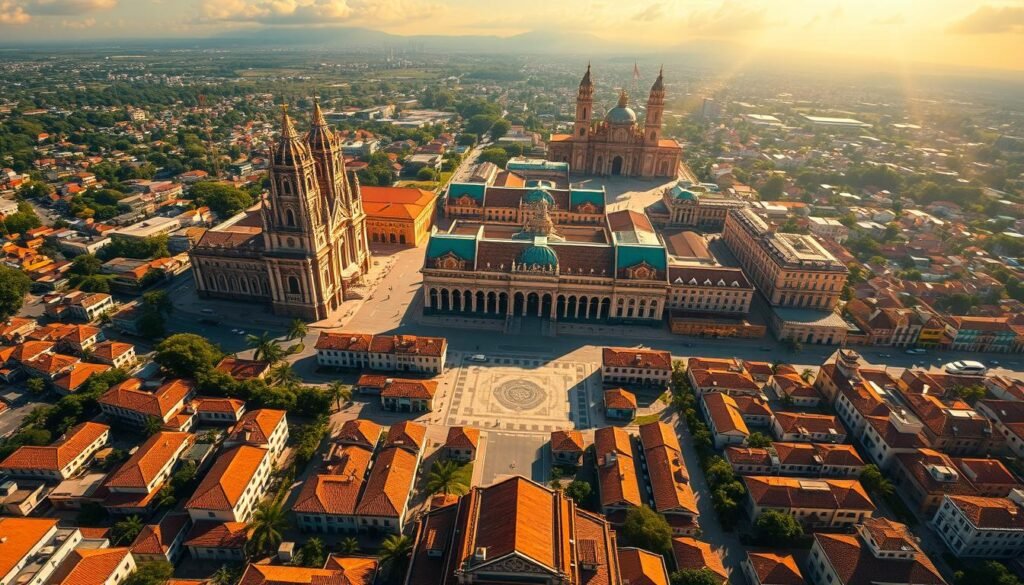
Public spaces and green areas are integral to the urban fabric. Parks and plazas provide areas for recreation and social interaction, enhancing the quality of life for residents. These spaces also contribute to environmental sustainability by improving air quality and reducing heat.
Historical examples underscore the success of these principles. The grid layouts of Roman cities and the controlled expansion of medieval towns laid the groundwork for modern planning. Today, these ideas continue to shape cities worldwide, including those in the Philippines.
The balance of order and flexibility is a hallmark of Spanish planning models. By combining structured layouts with adaptable designs, cities can meet the needs of their populations while maintaining long-term livability. These principles remain relevant as urban areas continue to grow and evolve.
Influence of Visionary Architects and Planners
The evolution of city design owes much to the groundbreaking ideas of visionary architects and planners. Their innovative approaches have shaped how we live, work, and interact in urban spaces. One such figure, Ildefons Cerdà, revolutionized the way cities are structured, leaving a lasting legacy that continues to inspire modern projects.
Ildefons Cerdà’s Revolutionary Concepts
Ildefons Cerdà, a pioneer in urban development, introduced the concept of the Eixample district in Barcelona. His vision emphasized egalitarian layouts, with uniform blocks and wide streets. This design aimed to improve accessibility and create a balance between growth and order.
Cerdà’s ideas were ahead of their time. He prioritized green spaces and public areas, ensuring that cities were not just functional but also livable. His work laid the foundation for modern city planning, influencing projects worldwide.
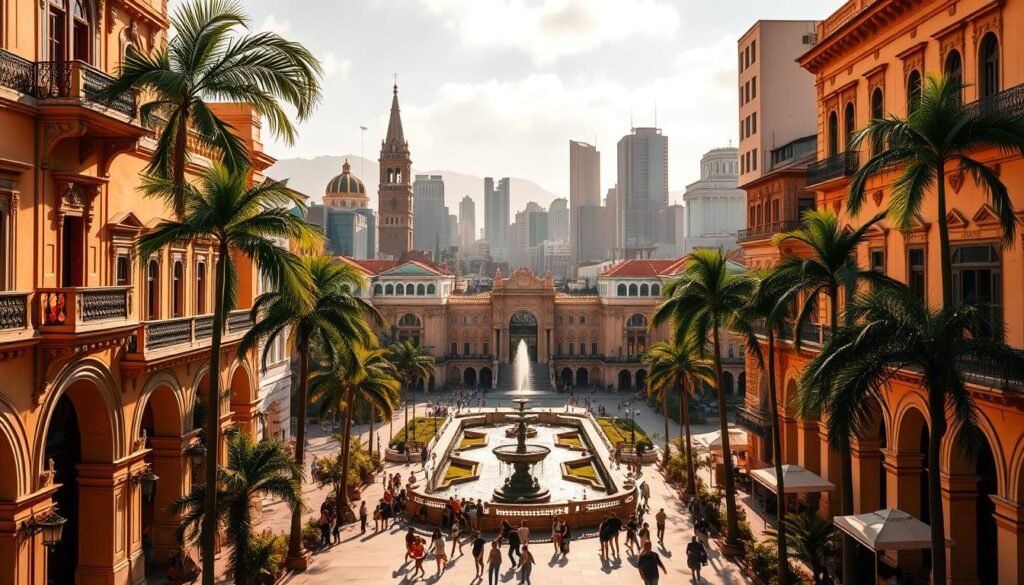
Modern Adaptations in Urban Design
Today, Cerdà’s principles are being adapted to meet contemporary needs. One notable example is the superblocks project in Barcelona. This initiative transforms nine-block areas into pedestrian-friendly zones, reducing car traffic and reclaiming space for public use.
The Poblenou neighborhood serves as a test case for this model. By limiting car speeds and creating new public squares, the project has improved air quality and encouraged cycling. Such adaptations demonstrate how historical ideas can evolve to address modern challenges.
- Cerdà’s egalitarian layouts remain a cornerstone of city design.
- Superblocks reduce traffic and enhance public spaces.
- Modern projects like Poblenou showcase the practical evolution of these ideas.
- Visionary planners continue to shape urban policy and development.
The impact of these visionary architects extends beyond their time. Their ideas continue to guide how cities grow, ensuring that urban spaces remain functional, sustainable, and inclusive for future generations.
Spanish Urban Planning in Practice
The transformation of city layouts over time reflects evolving needs and priorities. From restrictive walls to open grids, the design of urban areas has adapted to accommodate growth and improve functionality. This evolution is particularly evident in the shift from defensive structures to organized block systems.
The Evolution of Block Structures and Grid Layouts
Historically, cities were built with defensive walls to protect residents. However, as populations grew, these walls became barriers to expansion. The demolition of such structures marked a turning point, paving the way for grid layouts that prioritized accessibility and order.
Grid systems divide land into uniform blocks, making navigation and development easier. This approach, rooted in ancient practices, has been refined over the years. For example, Barcelona’s Eixample district introduced wide streets and organized blocks, setting a standard for modern city design.
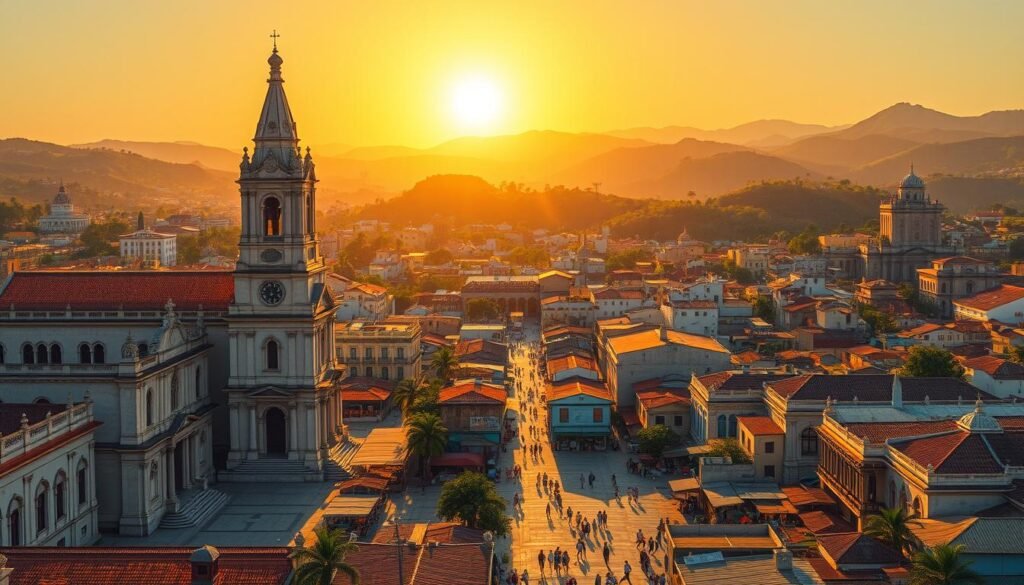
Modern adaptations, like the superblock model, have further transformed urban spaces. Superblocks reduce car traffic, reclaiming streets for pedestrians and public use. This initiative has improved air quality and encouraged cycling, demonstrating how historical ideas can evolve to address contemporary challenges.
| Era | Design Feature | Impact |
|---|---|---|
| Medieval | Defensive Walls | Limited expansion but provided security. |
| 19th Century | Grid Layouts | Improved accessibility and land use efficiency. |
| 21st Century | Superblocks | Reduced traffic and enhanced public spaces. |
These changes highlight the importance of adaptability in city planning. By learning from the past and addressing modern needs, urban areas can remain functional and sustainable for future generations.
Role of Urban Policy and Government Legislation
Government policies have long played a pivotal role in shaping the growth of cities. From historical fortifications to modern deregulation, legislative measures have both restricted and facilitated expansion. These policies ensure that development aligns with the needs of residents and the environment.
In the past, defensive walls limited city growth. However, the removal of such barriers allowed for controlled expansion. This shift paved the way for organized layouts, such as grid systems, which improved accessibility and land use efficiency.
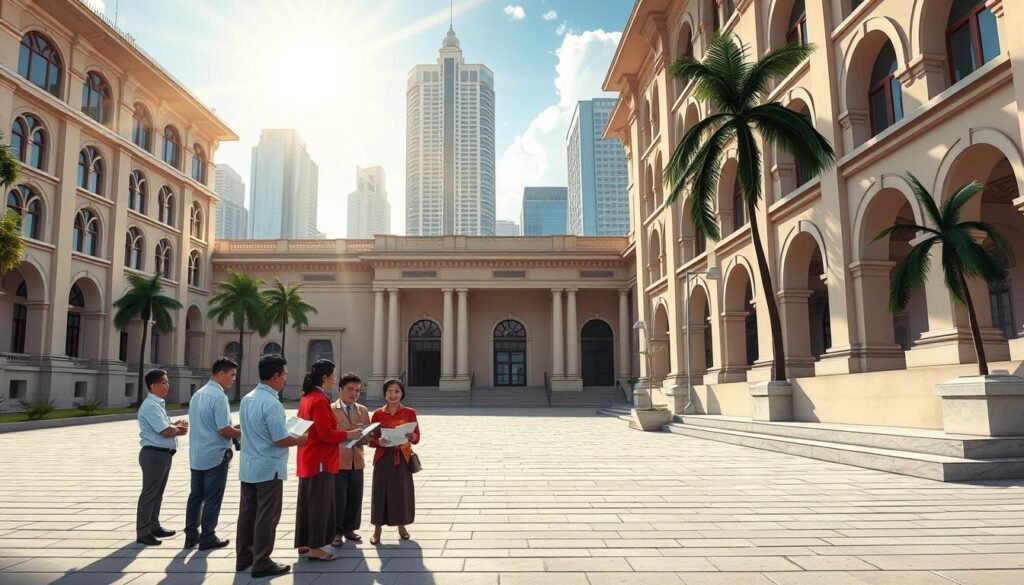
City councils play a crucial role in endorsing planning projects. Their decisions influence block size, public space allocation, and housing quality. For example, the superblock model in Barcelona reclaimed streets for pedestrians, reducing traffic and enhancing public areas.
Modern policies, like the Spanish Urban Agenda, focus on sustainable development. Approved in 2019, this framework includes 30 specific objectives and 291 lines of action. It aims to benefit over 8.5 million people by addressing social, economic, and environmental challenges.
Public engagement is also vital in driving urban change. Legal frameworks ensure that residents have a voice in the planning process. This balance between regulation and creative use of space fosters functional and inclusive cities.
| Policy | Impact |
|---|---|
| Defensive Walls | Limited expansion but provided security. |
| Grid Layouts | Improved accessibility and land use efficiency. |
| Superblocks | Reduced traffic and enhanced public spaces. |
By learning from historical practices and adapting to modern needs, cities can continue to grow sustainably. Government legislation remains a cornerstone of effective urban development, ensuring that cities remain livable for future generations.
Financial and Political Influences on Planning
Financial and political forces have long shaped the development of cities, often leaving lasting impacts on their layouts and functionality. From greed-driven decisions to resistance from local communities, these influences have redirected urban projects and altered their outcomes. Understanding these dynamics is crucial for creating sustainable and inclusive cities.
Impact of Greed and Resistance on Urban Transformation
Historically, financial greed has played a significant role in shaping city layouts. For example, in Barcelona, commercial pressures often clashed with public interests, leading to modifications in planned projects. Local resistance has also been a driving force, as communities pushed back against state-imposed changes that threatened their way of life.
One notable instance is the superblock model in the Poblenou neighborhood. While the project aimed to reduce traffic and reclaim public space, it faced opposition from businesses and residents. This resistance highlighted the challenges of balancing progress with community needs.
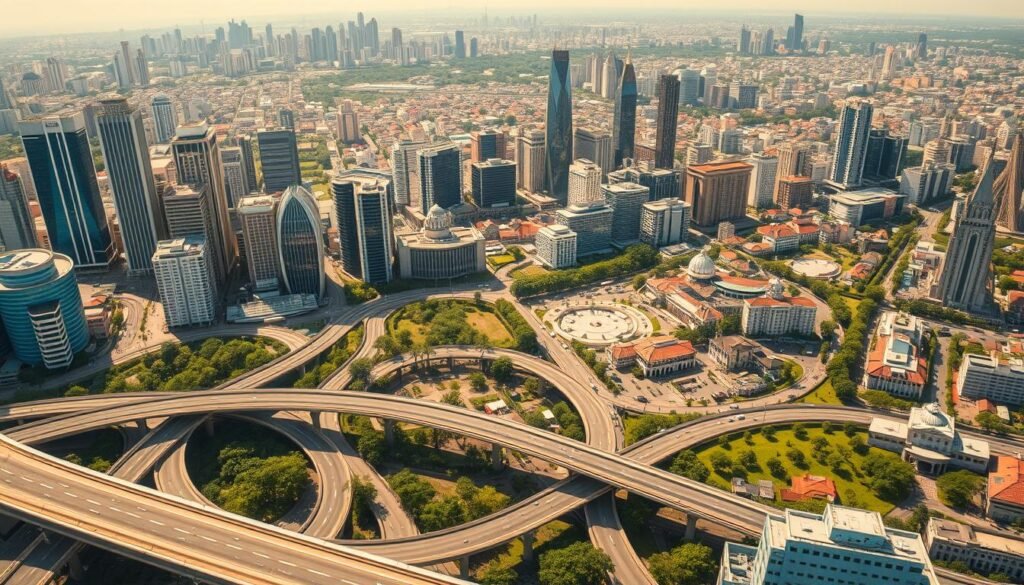
Policy Shifts and Their Long-Term Effects
Policy changes by the Spanish government have also redirected urban development. For instance, the 1979 National Policy for Urban Development marked a shift toward neoliberal practices, prioritizing economic growth over social equity. This agenda influenced land use, housing prices, and public space allocation, leaving a lasting mark on city layouts.
In Barcelona, legislative turnover led to the approval of the Spanish Urban Agenda in 2019. This framework includes 30 objectives and 291 lines of action, focusing on sustainable development and public engagement. Such policies demonstrate how government decisions can drive urban change.
| Influence | Example | Outcome |
|---|---|---|
| Financial Greed | Commercial pressures in Barcelona | Modified planned projects |
| Local Resistance | Opposition to Poblenou superblocks | Balanced progress with community needs |
| Policy Shifts | 1979 National Policy for Urban Development | Prioritized economic growth over equity |
These examples underscore the importance of aligning financial and political agendas with public interests. By learning from past experiences, cities can navigate these challenges and create spaces that benefit their populations.
Spanish Urban Planning: A Model for Change
Cities around the world have long looked to historical models for inspiration in shaping their futures. The principles of intentional design and adaptability continue to guide modern urban development, proving that lessons from the past remain relevant today.
Lessons from Historical Implementation
Historical urban planning models, like those developed by Ildefons Cerdà, have served as blueprints for transformative change. His grid layouts and emphasis on public spaces set a standard for functional and livable cities. These ideas have been adapted to meet the needs of growing populations and evolving technologies.
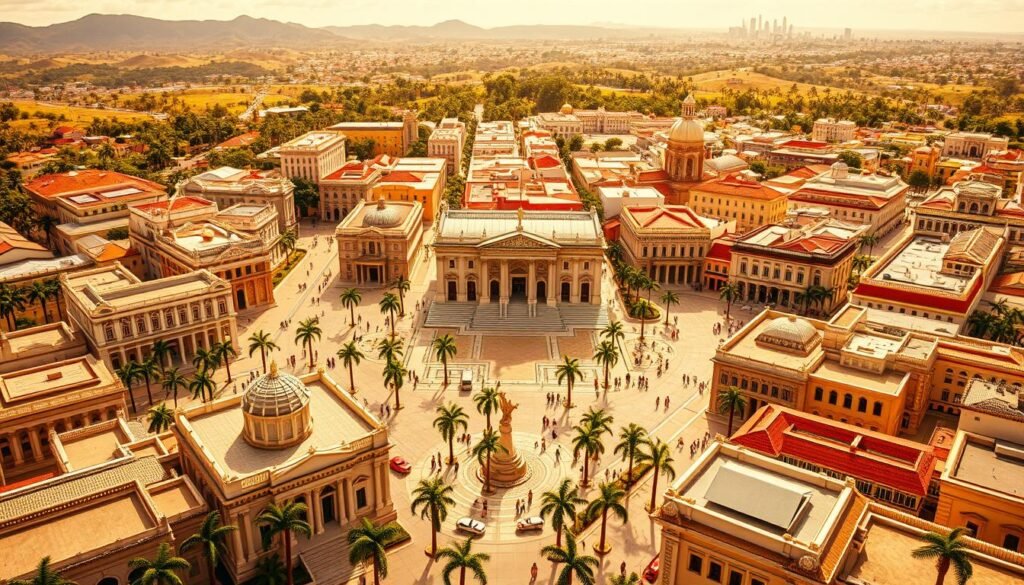
One key lesson is the importance of flexibility. For example, the superblock model in Barcelona reclaims streets for pedestrians, reducing traffic and enhancing public areas. This incremental change maintains the relevance of historical designs while addressing modern challenges.
Adaptability of Urban Structures Over Time
Urban structures must evolve to meet societal and technological needs. Grid and block systems, rooted in ancient practices, have been refined to improve accessibility and land use efficiency. Modern adaptations, like the Poblenou neighborhood, demonstrate the versatility of these methods.
- Grid systems provide a foundation for organized development.
- Superblocks reduce traffic and reclaim public space.
- Incremental changes ensure long-term relevance.
These examples highlight the adaptability of urban planning principles. By learning from the past and addressing contemporary needs, cities can remain functional and sustainable for future generations. For more insights into how historical models influence modern cities, explore this detailed analysis.
Influence on Barcelona’s Urban Transformation
Barcelona’s transformation into a modern metropolis is a story of strategic planning and bold initiatives. Over the decades, the city has redefined its streets, neighborhoods, and public spaces to meet the needs of its growing population. This evolution showcases how thoughtful design can revitalize urban areas and improve quality of life.
One of the most significant phases of this transformation began with the 1992 Olympic Games. The event served as a catalyst for major infrastructure projects, including the redevelopment of industrial zones along the waterfront. These areas, once neglected, were transformed into vibrant communities with improved housing and green spaces.
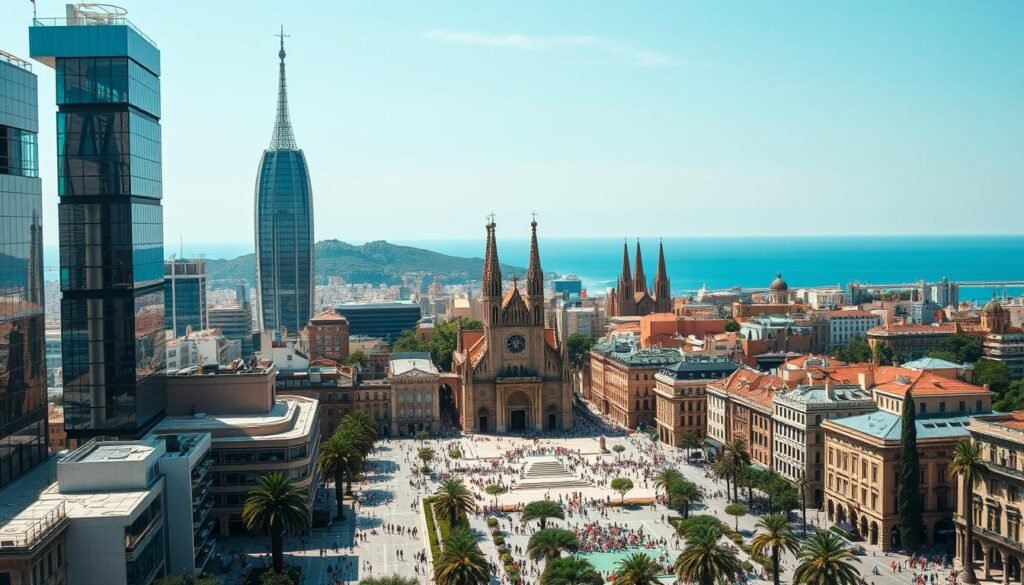
The superblocks project is another key initiative that has reshaped the city. By reclaiming streets for pedestrians and reducing car traffic, this model has freed up to 92% of public space. Neighborhoods like Poblenou have seen improved air quality, reduced noise, and enhanced community interaction as a result.
Population pressures and urban agendas have also driven major developments. The city’s Eixample district, designed with wide streets and uniform blocks, set a standard for organized growth. Today, this approach continues to guide new projects, ensuring that Barcelona remains a functional and livable city.
- The Olympic legacy revitalized industrial zones and improved infrastructure.
- Superblocks reclaimed streets, creating more space for pedestrians and green areas.
- Population growth spurred the need for better housing and public services.
- Strategic planning has made Barcelona a model for sustainable urban development.
These changes have had a practical impact on everyday life in the city. Residents now enjoy cleaner air, safer streets, and more opportunities for recreation. Barcelona’s transformation demonstrates how innovative planning can address modern challenges while preserving the city’s unique character.
Key Features of the Spanish Urban Planning Model
Public spaces play a crucial role in shaping livable environments. The Spanish urban planning model stands out for its innovative use of these areas, integrating them into the fabric of cities. From superblocks to green spaces, this approach fosters community engagement and sustainability.
Innovative Use of Public Space and Superblocks
The superblock model is a defining feature of this planning approach. By reclaiming streets for pedestrians, it reduces traffic and enhances public areas. For example, Barcelona’s Poblenou neighborhood has seen improved air quality and increased community interaction thanks to this initiative.
This model transforms nine-block areas into pedestrian-friendly zones. It prioritizes accessibility and reclaims up to 92% of public space for community use. Such designs demonstrate how historical ideas can evolve to meet modern needs.
Integration of Green and Civic Areas
Green spaces are another cornerstone of the Spanish model. Parks and plazas are woven into the urban fabric, improving air quality and offering recreational opportunities. These areas also serve as hubs for social interaction, enhancing the quality of life for residents.
Barcelona’s Eixample district exemplifies this integration. Its wide streets and uniform blocks are complemented by strategically placed green areas. This balance between order and flexibility ensures that cities remain functional and adaptable.
“The inclusion of green spaces and public areas is not just about aesthetics; it’s about creating sustainable and livable cities.”
The Spanish urban planning model also emphasizes the balance between uniformity and flexibility. While grid layouts provide structure, the adaptability of designs ensures they remain relevant over time. This approach has made cities like Barcelona a model for sustainable development.
| Feature | Description | Impact |
|---|---|---|
| Superblocks | Reclaims streets for pedestrians and reduces traffic. | Enhances public space and air quality. |
| Green Spaces | Integrates parks and plazas into urban areas. | Improves air quality and community interaction. |
| Grid Layouts | Provides structured and organized development. | Ensures accessibility and land use efficiency. |
These features highlight the transformative impact of the Spanish model. By focusing on public space and sustainability, it creates cities that are both functional and livable. For more insights into urban development, explore this detailed analysis.
Contemporary Urban Challenges Addressed by Historical Models
Urban centers today face a growing list of challenges, from overcrowding to pollution. As populations increase, cities must find innovative ways to manage these issues. Historical models, particularly those rooted in intentional design, offer proven solutions that remain relevant in modern contexts.
One of the most pressing issues is traffic congestion. Narrow streets and increasing vehicle numbers have made movement difficult in many areas. Historical grid layouts, with their wide streets and organized blocks, provide a blueprint for easing traffic flow. For example, Barcelona’s superblock model reclaims streets for pedestrians, reducing car dependency and improving safety.
Another challenge is the lack of green spaces. As cities expand, parks and recreational areas often get overlooked. Historical planning emphasized the integration of green areas into the urban fabric. This approach not only improves air quality but also enhances the quality of life for residents.
- Grid layouts improve accessibility and reduce traffic congestion.
- Superblocks reclaim public space for pedestrians and cyclists.
- Green spaces enhance air quality and provide recreational opportunities.
Housing shortages are also a major concern. Rising populations demand more residential areas, often leading to overcrowded neighborhoods. Historical models, like Barcelona’s Eixample district, demonstrate how uniform blocks and organized development can create balanced housing solutions.
Climate change adds another layer of complexity. Cities must adapt to rising temperatures and extreme weather events. Traditional planning methods, such as the use of wide streets and green spaces, help mitigate these effects by improving airflow and reducing heat islands.
By integrating historical principles with modern needs, cities can address these challenges effectively. For instance, the superblock model has been adapted to reduce pollution and enhance public spaces in densely populated areas. These adjustments show how tradition and innovation can work together to create sustainable urban environments.
As urbanization continues, the lessons from historical models remain invaluable. They provide a foundation for creating cities that are not only functional but also livable for future generations.
Transportation and Mobility in Planned Cities
Efficient transportation systems are the backbone of any thriving city. From historic grid designs to modern transit solutions, the way we move shapes the functionality and livability of urban areas. Early planners laid the groundwork for today’s mobility strategies, emphasizing accessibility and reducing congestion.
Historic Designs Influencing Modern Transit Solutions
Historic grid layouts have played a significant role in shaping modern transportation systems. These designs, characterized by organized roads and uniform blocks, made navigation easier and improved land use efficiency. For example, Barcelona’s grid system, introduced in the 19th century, set a standard for structured development.
Over time, these layouts evolved to accommodate growing populations and changing needs. Wider streets and pedestrian-friendly zones became essential components of urban planning. Today, these principles are adapted to address modern challenges like traffic congestion and pollution.
- Grid systems improve accessibility and reduce travel times.
- Pedestrian-friendly zones encourage walking and cycling.
- Wider streets accommodate both vehicles and public transport.
One notable example is the superblock model in Poblenou. This project reclaims space for pedestrians, reducing car dependency and enhancing community interaction. Such innovations demonstrate how historic ideas can evolve to meet contemporary needs.
Integrating transit considerations into urban development is crucial for creating sustainable cities. By learning from the past and addressing modern challenges, planners can design transportation systems that are efficient, accessible, and environmentally friendly. For more insights into sustainable urban transport systems, explore this detailed analysis.
The Impact of Spanish Urban Planning on Philippine Cities
The design of cities often reflects the cultural and historical influences that shape them. In the Philippines, the legacy of Spanish colonial rule has left a lasting mark on urban development. From grid layouts to public spaces, these influences continue to guide how cities grow and function today.
Historical Comparisons and Cultural Parallels
Spain’s urban planning principles, such as the grid system, were introduced to the Philippines during colonial rule. These designs emphasized order and accessibility, creating structured layouts that remain evident in cities like Manila. The integration of public spaces, such as plazas and parks, also reflects Spanish traditions of community gathering.
In contrast, modern Philippine cities face unique challenges, such as rapid population growth and traffic congestion. These issues require innovative solutions that blend historical practices with contemporary needs. For example, the superblock model, pioneered in Barcelona, offers a way to reclaim public space and reduce car dependency.
Localized Implementations in the Philippines
Philippine cities have adapted Spanish planning principles to address local challenges. One notable example is the use of grid layouts in newer developments, which improve accessibility and land use efficiency. Public spaces, like parks and plazas, are also being integrated into urban areas to enhance community interaction.
Projects like the Bonifacio Global City demonstrate how historical models can be modernized. This development features wide streets, organized blocks, and green spaces, creating a balanced and functional environment. Such initiatives highlight the transfer of planning techniques from Spain to the Philippines.
“Adapting historical planning models to modern needs ensures that cities remain functional and sustainable for future generations.”
Parallels between Barcelona and Philippine cities are evident in their approach to public spaces. Both emphasize the importance of green areas and pedestrian-friendly zones. However, the Philippines faces additional challenges, such as limited land availability and environmental concerns, which require tailored solutions.
| Feature | Barcelona | Philippine Cities |
|---|---|---|
| Grid Layouts | Organized blocks and wide streets | Improved accessibility and land use |
| Public Spaces | Parks and plazas for community use | Integrated green areas and plazas |
| Superblocks | Reclaims streets for pedestrians | Reduces traffic and enhances public space |
As Philippine cities continue to grow, lessons from Spanish urban planning remain invaluable. By blending historical practices with modern innovations, planners can create sustainable and livable environments. For more insights into addressing urban challenges in the Philippines, explore this detailed analysis.
Spanish Urban Planning and Modern Sustainability Goals
Modern cities are increasingly focusing on sustainability to address environmental challenges. Historical planning models, like those from Barcelona, are being adapted to meet these goals. These methods emphasize green spaces, efficient land use, and reduced pollution, creating healthier urban environments.
Green Space and Pollution Reduction Initiatives
One key initiative is the integration of green areas into urban layouts. Parks and trees not only improve air quality but also reduce noise and heat. For example, Barcelona’s superblocks reclaim streets for pedestrians, reducing car traffic and enhancing public spaces.
Traditional planning methods also help reduce energy and resource consumption. Organized block systems and wide streets improve airflow, lowering the need for air conditioning. These designs are part of a broader agenda to create sustainable and livable cities.
City councils play a crucial role in driving these changes. Policies that prioritize green spaces and efficient land use are essential. For instance, the Spanish Urban Agenda includes 30 objectives focused on sustainability and public well-being.
“Green spaces are not just about aesthetics; they are vital for reducing pollution and improving quality of life.”
Future directions will blend historical methods with modern targets. Projects like Barcelona’s superblocks demonstrate how traditional layouts can evolve to meet contemporary needs. By focusing on sustainability, cities can create environments that benefit both residents and the planet.
For more insights into how urban planning supports sustainability, explore this detailed analysis.
Public Engagement and Community Involvement
Engaging communities in city development ensures projects meet real needs. When residents take part in planning, cities become more inclusive and functional. Public involvement is not just a step in the process; it’s the foundation of successful urban transformation.
Lessons from Barcelona’s Superblocks Projects
Barcelona’s superblocks are a prime example of how community engagement can shape urban spaces. By reclaiming streets for pedestrians, this initiative has improved air quality and created vibrant public areas. Residents played a crucial role in shaping the project, ensuring it aligned with their daily lives.
Effective public consultation requires a clear agenda and open communication. In Barcelona, planners held workshops and town meetings to gather feedback. This approach ensured that the superblocks met the needs of diverse groups, from families to local businesses.
“Involving the community isn’t just about listening; it’s about acting on what we hear to create better spaces for everyone.”
Local councils and city planners must prioritize transparency and accountability. By sharing project details and timelines, they build trust with residents. This trust is essential for long-term success, as seen in the maintenance of public spaces in Barcelona.
- Workshops and town meetings foster open dialogue.
- Transparent communication builds trust with residents.
- Community input ensures projects align with local needs.
Collaborative decision-making leads to more sustainable and livable cities. When residents feel heard, they are more likely to support and maintain public spaces. This approach not only improves the area but also strengthens the sense of community.
From Barcelona to smaller towns, the principles of public engagement remain the same. By involving residents in every step, cities can create spaces that truly serve their populations. This inclusive approach is the key to building a sustainable urban future.
The Challenges of Adapting Traditional Plans Today
Adapting traditional city designs to modern needs is no small feat. As populations grow, the mismatch between outdated grids and current demands becomes more apparent. Cities face the challenge of updating infrastructure while preserving their historical identity.
One major obstacle is population density. Traditional layouts, designed for smaller populations, struggle to accommodate today’s urban growth. For example, narrow streets in historic districts often lead to traffic congestion, making mobility a significant issue.
Another challenge is balancing preservation with progress. Cities like Barcelona have faced resistance when introducing modern solutions, such as the superblock model. While this initiative reclaims public space, it also requires careful planning to avoid disrupting the historical fabric of the area.
Infrastructure updates are equally complex. Modern utilities, such as broadband and green energy systems, must be integrated without compromising the integrity of historic buildings. This requires innovative approaches and flexible models that can evolve with changing needs.
Policy updates are essential to address these challenges. Timely adjustments to zoning laws and development agendas can help cities adapt while maintaining their unique character. For instance, Manila’s urban design has evolved by blending traditional layouts with modern innovations, as seen in this detailed analysis.
| Challenge | Solution | Example |
|---|---|---|
| Population Density | Expand public transport and green spaces | Barcelona’s superblocks |
| Preservation vs. Progress | Flexible zoning laws | Manila’s urban design |
| Infrastructure Updates | Integrate modern utilities without disrupting history | Green energy systems in historic districts |
Ultimately, the key to success lies in creating adaptable models that respect the past while embracing the future. By addressing these challenges, cities can remain functional, sustainable, and true to their roots.
Spanish Urban Planning in the Global Context
Cities worldwide are increasingly turning to innovative models to address modern challenges. The approach seen in Barcelona has become a blueprint for sustainable and functional city design. Its principles of organized layouts, green spaces, and pedestrian-friendly zones are now being adapted globally.
International Perceptions and Applications
The global appeal of Barcelona’s techniques lies in their adaptability. Cities like Bogotá and Melbourne have integrated elements of the superblock model to reduce traffic and enhance public spaces. These adaptations show how historical ideas can evolve to meet contemporary needs.
International collaborations have further amplified this influence. Planners from Barcelona often work with counterparts in other countries to share insights and refine strategies. This exchange of ideas fosters a global community focused on sustainable development.
Comparative studies highlight the success of these techniques. For example, a project in Bogotá reclaimed streets for pedestrians, improving air quality and community interaction. Such initiatives demonstrate the practical impact of adopting Barcelona’s methods.
“The global adoption of these techniques shows that thoughtful design can transform cities into livable, sustainable spaces.”
Future trends in global development will likely continue to draw from these models. As cities grow, the balance between order and flexibility remains essential. By learning from Barcelona, planners can create environments that are both functional and adaptable.
| City | Adapted Technique | Outcome |
|---|---|---|
| Bogotá | Superblocks | Reduced traffic, improved air quality |
| Melbourne | Pedestrian-friendly zones | Enhanced public spaces |
| Manila | Grid layouts | Improved accessibility |
For more insights into how these models influence global cities, explore this detailed analysis on sustainable urban development.
Conclusion
From historical grids to modern superblocks, city layouts have evolved to meet growing needs. Barcelona’s innovative approaches, like the superblock model, demonstrate how traditional designs can address modern challenges such as traffic and pollution. These methods have inspired cities worldwide, showing the lasting impact of thoughtful development.
Lessons from historical models remain relevant today. By integrating green spaces and prioritizing accessibility, cities can create sustainable environments. The balance of order and flexibility ensures that urban areas remain functional and adaptable for future generations.
As cities continue to grow, the principles of intentional design offer valuable strategies. Reflecting on these practices can guide city planners in regions like the Philippines, where rapid urbanization presents unique challenges. Thoughtful integration of historical wisdom with modern needs will shape sustainable and livable cities for years to come.
FAQ
What are the core principles of Spanish urban planning?
The core principles include intentional city design, geographic boundaries, and the integration of public spaces. These ideas focus on creating functional, sustainable, and community-oriented environments.
How did Ildefons Cerdà influence modern urban design?
Ildefons Cerdà introduced revolutionary concepts like the grid layout and superblocks. His work in Barcelona emphasized open spaces, efficient transportation, and improved living conditions.
What role does public space play in Spanish urban planning?
Public space is central to the model, promoting social interaction and accessibility. Innovations like superblocks reduce traffic and enhance green areas, improving quality of life.
How has Spanish urban planning influenced global cities?
Its principles, such as grid layouts and green integration, have inspired cities worldwide. The adaptability of these ideas helps address modern challenges like pollution and overcrowding.
What are the challenges of adapting traditional Spanish urban plans today?
Challenges include balancing historical designs with modern needs, managing resistance to change, and ensuring policies align with sustainability goals.
How does Spanish urban planning address transportation and mobility?
Historic designs prioritize pedestrian-friendly streets and efficient transit systems. Modern adaptations focus on reducing car dependency and improving access to public transport.
What lessons can be learned from Barcelona’s superblocks project?
The project highlights the importance of community involvement, reducing traffic, and creating green spaces. It serves as a model for sustainable urban transformation.
How does Spanish urban planning align with modern sustainability goals?
It emphasizes green spaces, pollution reduction, and energy efficiency. These goals are integrated into city designs to create healthier, more sustainable environments.
Source Links
- Building inclusive & sustainable cities
- Colonial Urban Planning and Land Structures in the Philippines, 1521-1898
- Barcelona’s remarkable history of rebirth and transformation
- Urban planning
- Urban Design and Planning: Integrating Nature and the Built Environment
- The Foundational Process of Cities in Spanish America: The Law of Indies as a Planning Tool for Urbanization in Early Colonial Towns in Venezuela
- The Spanish Colonial Town: Planning Flexibility in Spite of the Grid
- 2025 Urban Planning in Spanish: Key Terms » Archova Visuals
- White Paper on Sustainability of Spanish Urban Planning — 1 Introduction
- The new Urban Planning Law of Andalusia in 10 key ideas
- Redesigning the Grid: Barcelona’s Experiment with Superblocks
- Barcelona’s superblocks are a new model for “post-car” urban living
- Paolo Soleri, Visionary Who Merged Architecture with Environmentalism, Dies at 93
- What is the Spanish Urban Agenda?
- Building inclusive & sustainable cities
- Spatial Correlation between Urban Planning Patterns and Vulnerability to Flooding Risk: A Case Study in Murcia (Spain)
- Five regions and more than 120 cities in Spain implement the New Urban Agenda
- Development, urban planning and political decisions. A triad that built territories at risk – Natural Hazards
- Housing bubbles and land planning corruption: evidence from Spain’s largest municipalities
- The Evolution of Urban Planning in Medium-Sized Catalan Cities (1979–2019)
- Smart Sustainable Cities in Spain: The Commitment to a Green Economy
- Urban Planning, Environment and Health Initiative – ISGLOBAL
- Urban planning of Barcelona
- No title found
- Urban planning with superblocks: Barcelona, Spain – EBRD
- The Standardized Planning of Latin American Cities: Tracing the Blueprint of the Laws of the Indies
- Bottom-up urban planning for fair and climate-resilient cities | Transformative Urban Coalitions United Nations University – Institute for Environment and Human Security
- Urban Scene Protection and Unconventional Practices—Contemporary Landscapes in World Heritage Cities of Spain
- Urban mobility in the future: text analysis of mobility plans – European Transport Research Review
- Sustainable Urban Mobility Plans: How Do They Work?
- From Spanish Haciendas to Condominium Living: Tracing the Evolution of Real Estate in the Philippines
- Overview
- Frontiers | Sustainable Development Goal 11 and a New Urban Agenda for Caribbean Small Island Developing States: Policy, Practice, and Action
- How Does Urban Planning Affect Human Health? Our Health and the Health of Our Planet Depend on the Design of Our Cities – Blog – ISGLOBAL
- 6 Tips for Inclusive Public Meetings
- Fostering Community Engagement Through Knowledge Exchange and Co-Creation (Learning and Action Alliances) –
- What are the most effective strategies for engaging with community groups?
- Context-Adapted Urban Planning for Rapid Transitioning of Personal Mobility towards Sustainability: A Systematic Literature Review
- Beyond material and design: Bridging urban climate adaptation to Europe – Foresight
- Using Maps to Boost the Urban Proximity: Analysis of the Location of Public Facilities According to the Criteria of the Spanish Urban Agenda
- Urban Growth and Long-Term Transformations in Spanish Cities Since the Mid-Nineteenth Century: A Methodology to Determine Changes in Urban Density
- The City Beautiful and the Globalization of Urban Planning
- Principles and practices of urban planning: Part 1 colonial planning
- Liveability Versus Sustainability in Spanish Cities: First Evidences Using Synthetic Indicators – Applied Research in Quality of Life
- History of Urban Planning in the Philippines: 10 Turning Points – EnP Tinio

